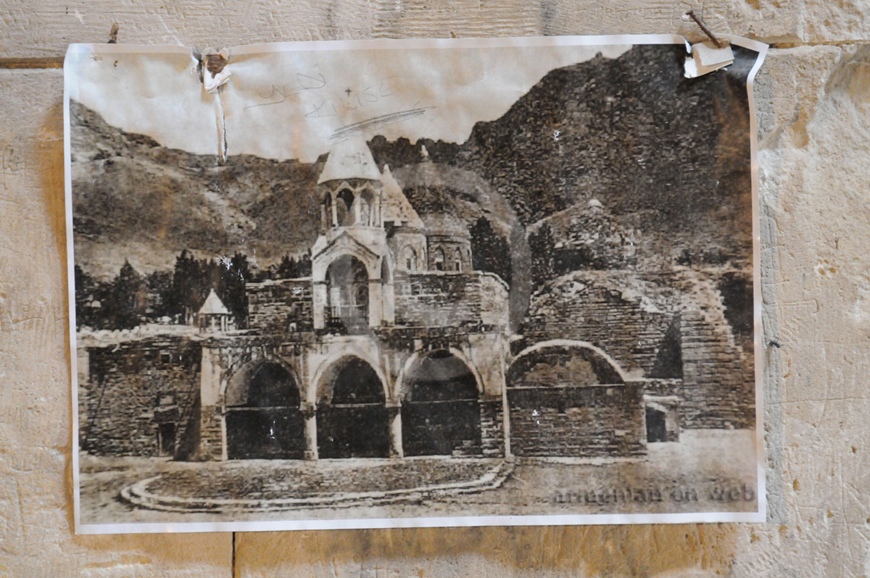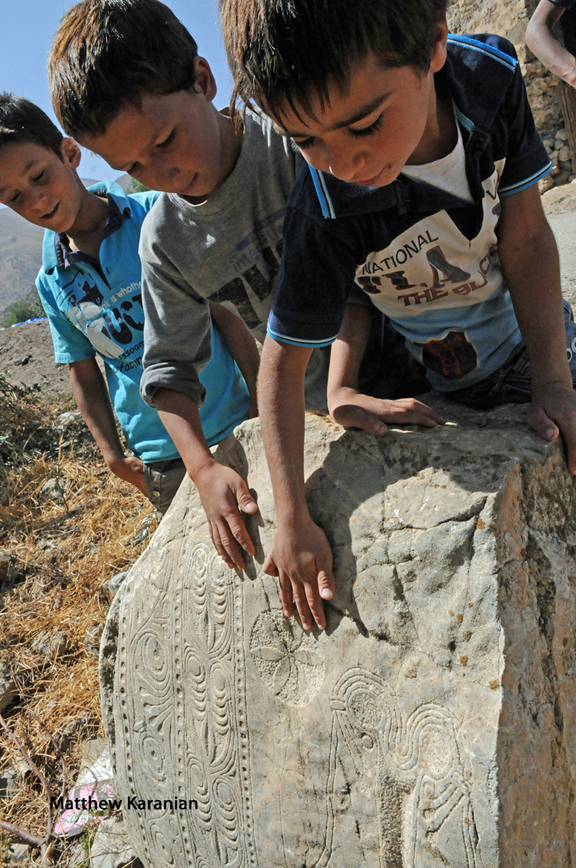Searching for the ‘Armenia’ in Historic Armenia, and Finding A Small Bit of It
Searching for the ‘Armenia’ in Historic Armenia, and Finding A Small Bit of It –
The exterior of the Armenian Church of the Savior at Ani is covered with scaffolding in September, 2013. Photo © 2013 Matthew Karanian, Reprinted with Permission.
PHOTOS AND STORY
BY MATTHEW KARANIAN
Travelers who are looking for anything Armenian in ancient Armenia have long become accustomed to finding plenty of disappointment, as well.
But when I traveled throughout Historic Armenia last month, I also found a bit of cause for cautious optimism—and bewilderment.
I was in Historic Armenia—a vast geographic area that includes both Western Armenia and also the lost Eastern Armenian lands of Ani and Kars—while doing research and photography for a future book.
I had good reason to expect that the remaining Armenian sites would be in worse shape than I remembered them. Why? Because we’ve already seen this tragedy recur countless times: an Armenian church that has stood for centuries inexplicably falls down. Then the church disappears. And finally, the church never existed.

A photograph of Varagavank as it appeared prior to April, 1915, hangs from an interior wall of the remnants of this once majestic Armenian monastery. LPhoto © 2013 Matthew Karanian, Reprinted with Permission.
Several years ago, during my first trip to the ancient Armenian church of Holy Cross (Soorp Khatch) on the island of Aghtamar, I observed that the site had suffered significant vandalism. When I returned a few years later, the vandalism was worse.
When I sought out the majestic monastery of Varagavank, located on a hilltop above the town of Van, I was disappointed again.
I struggled to locate the site, even as I walked amid its ruins. I was in the right place, but where was the church?
Hay for livestock, stacked floor to ceiling, had disguised the chapels. Other parts of the monastery were similarly camouflaged. I finally found the ruins of the church. I also found the sadness of knowing that such a mighty site could have been become so diminished.
My travels throughout Historic Armenia a decade ago revealed a persistent erosion of the evidence of our civilization. I was disappointed and saddened to see that everything Armenian was disappearing.
And so I was puzzled last month when I encountered people in Ani who appeared to be repairing Armenian churches, rather than destroying them. I saw workers who were shoring buildings up, rather than pulling them down.
Ani, the ancient Armenian capital, and the fabled city of a thousand churches, had appeared to be on the verge of collapse when I walked the site a decade ago. Now, an effort appears to be underway to save what’s left.
What was going on here?

The remains of Varagavank as it appeared in September, 2013. Photo © 2013 Matthew Karanian, Reprinted with Permission.
A Notorious ‘Restoration’ By Turkey
My travels took me on a swath through Armenian Diyarbakir, Van, Kars, and Ani. I visited as many Armenian sites as I could find. I saw ruins and repairs. I saw clumsy restorations. And I saw one horribly botched renovation at Edremit, just outside Van.
I didn’t see a trend, but amid all the work, I did see some hopeful signs pointing to the preservation, at least for a while, of some of the last surviving Armenian sites.
The reconstruction of Soorp Khatch at Aghtamar is perhaps the most notorious and widely publicized of the church repair projects in Historic Armenia. This tenth-century church was seized by Turkey following the Genocide, then largely ignored for 90 years, before being subjected to a controversial, perhaps unnecessary, restoration and alteration.

Kurdish children in a village near the shore of Lake Van look at the ancient Armenian inscriptions on a rock near an abandoned, ruined Armenian church. Photo © 2013 Matthew Karanian, Reprinted with Permission.
Roofs were reconstructed and altered from their original design and flooring was changed. Critics say that some of the materials used in the repair work are inappropriate, as well, having been milled by machine, rather than by hand.
The Turkish government now considers the church to be a museum, and since 2010 it has allowed the Armenian Church to openly perform the rites of the church—the badarak—once each year. This year, for the first time since 1915, the Church also performed the rite of baptism.
To be sure, there have been furtive church services and prayers at Aghtamar over the years. I was present in 1997 when Archbishop Mesrob Ashjian led us in prayer. And it’s difficult to be overjoyed that a foreign government allows the Armenian Church to use one of its most cherished churches as a church, once each year.
Still, who could have foreseen just a decade ago that the rites of the Church might be openly performed at Aghtamar ever again? Roughly one thousand people attended the badarak this year. I was one of them.
The Armenian Patriarch Gets Involved
Aghtamar’s tentative reemergence as an Armenian Church once each year isn’t the only cause for optimism. The eleventh century monastery of Varagavank has also seen a transformation during the past several years, with the participation of the Armenian Patriarch of Istanbul.
Varagavank is located about seven miles from the town of Van, and is known to local Kurds as Yedi Kilesi, which means Seven Churches.
The remnants of this once-mighty monastery, which a decade ago served as a granary and a stable, have now been returned to use as a church. A Kurdish village grew up around Varagavank during the century following the Genocide, and there are no Armenians living here, so the church doesn’t see much use.
But the existence of this church as a church, instead of as a barn, is reason for optimism about the future of other Armenian sites in this region. If the local population can tolerate Varagavank, perhaps other Kurdish communities can tolerate Armenian sites in their midst, as well.

A Kurdish villager opens the door to the what’s left of the ancient Armenian monastery of Varagavank. This villager is the caretaker of the ruined site, which locals refer to as Yedi Kilesi, or Seven Churches. Photo © 2013 Matthew Karanian, Reprinted with Permission.
Funding for the cleanup of the site, and for the salary of a caretaker, is provided by the Armenian Patriarch of Istanbul. There has been no architectural restoration of the site. Indeed, an earthquake just a couple of years ago caused further damage to the structure and destroyed an arched entry.
Discerning from the exterior that this was once a fine monastery, and an architectural gem, is still difficult. There’s no mistaking the identity of this Armenian site on the inside. There’s an altar, an Armenian cross, and a stand for candles. A black and white photograph of the monastery, as it appeared prior to 1915, is prominently displayed on the wall of one of the surviving chapels.
The criticism that attached to the repairs of Aghtamar—that the work was done so that Turkey could trumpet the site as an example of its benevolence—has not been voiced at Varagavank.
Perhaps this is because the Turkish government didn’t pay for the repairs here, and hasn’t claimed that the site is a museum. The absence of Turkish involvment in the restoration of Varagavank allows Turkey to avoid answering questions about the circumstances of the destruction of this monastery by the Turkish Army in 1915, during the seige of Van.
Still, the community’s tolerance of the return of Varagavank as a church suggests there might be a greater tolerance for Armenian sites elsewhere in the region, too, just as there is in Diyarbakir—a large city located west of Lake Van.
Diyarbakir is today a Kurdish stronghold, but until the Genocide it was a multicultural city shared by Kurds and Armenians alike. Today this thriving center of Kurdish population is home to the largest functioning Armenian church in Turkey. This church, Soorp Giragos, was restored in 2007 and is now a model for Armenian-Kurdish reconcilation. The restoration was championed by the local Kurdish government.
Saving Ani
But it was Ani that most dramatically captured my attention as an example of apparent Turkish concern for the preservation of Armenian monuments. The condition of the surviving churches of Ani has become perilous in recent years. The site is directly on the international border between modern Turkey and the Republic of Armenia. Across the border, which is delineated by the Akhurian River, a quarry scars the view from Ani.

The Armenian Patriarch of Istanbul (right) leads a procession following the badarak, or Divine Liturgy, at Soorp Khatch, the Church of the Holy Cross, at Aghtamar on September 8, 2013. Photo © 2013 Matthew Karanian, Reprinted with Permission.
Critics say that heavy blasting at the quarry a decade ago also threatened the stability of the churches of Ani. Today, the blasting is reported to occur less frequently, and with less intensity.
On the western side of the Akhurian River, the Turkish government has undertaken measures to preserve the surviving churches. Steel braces have been used to shore up the walls of churches and to reinforce the foundations.
Some roofs have been sealed to prevent deterioration from the elements. This is not a restoration or a renovation, but rather an apparent effort to delay the destruction of the site. The motivation for the work appears to be tourism. If the buildings can be saved, there may be money to be earned from tourists who will come to visit them.

A crowd of about 1,000 parishioners gather in the church yard of Soorp Khatch, the Church of the Holy Cross, following the annual badarak, or Divine Liturgy, on September 8, 2013. Photo © 2013 Matthew Karanian, Reprinted with Permission.
Motivated By Money And Politics
Drawing an accurate conclusion from these observations is not easy.
The Turkish repairs at Aghtamar may have been motivated, some say, by the politics of appearing to be benevolent. By allowing a Christian minority to pray at its church once each year, Turkey shows the Europeans that it is tolerant and kind.
The Kurdish oversight of the restoration of Soorp Giragos in Diyarbakir may indeed have been benevolent. Or it might simply be part of an effort to enlist the Armenians as an ally in a political struggle against Turkey.
And the modest preservation efforts at Ani might be motivated by nothing greater than a desire for tourist revenue.
Regardless of the motivation, however, it seems that for at least some Turks and Kurds, ancient Armenian churches in Turkey are today more valuable as churches than as quarry material.
Matthew Karanian is an author and attorney, and he practices law in Pasadena, Calif. He has spent several years working in Armenia as both law professor and Associate Dean at the American University of Armenia. His latest book is ‘Armenia and Karabakh: The Stone Garden Travel Guide and he is currently working on a new book about Historic Armenia that will be published in 2015. Book details at ArmeniaTravelGuide.com and at Amazon.com

The Armenian Patriarch of Istanbul performs the rite of baptism at Aghtamar on September 8, 2013. Four Armenians were baptised during this ceremony, which was the first baptism here since 1915. Photo © 2013 Matthew Karanian, Reprinted with Permission.
‘Historic Western Armenia’ Explained
The terms “Historic Armenia” and “Western Armenia” are frequently used interchangeably to refer to those historic Armenian lands that lie outside the modern borders of the Republic of Armenia. The terms do not always refer to the same location, however.
Some historians, for example, consider the lost historic Armenian lands of Ani and Kars to be part of Eastern Armenia. For ease of reference, this story uses the terms interchangeably to identify those historic Armenian lands that are located west of the modern border between Turkey and Armenia, and within the political boundaries of Turkey.

